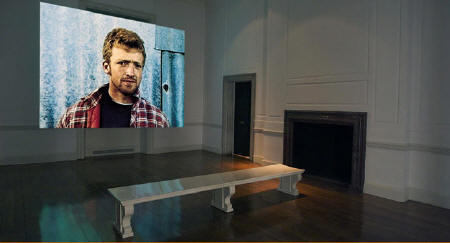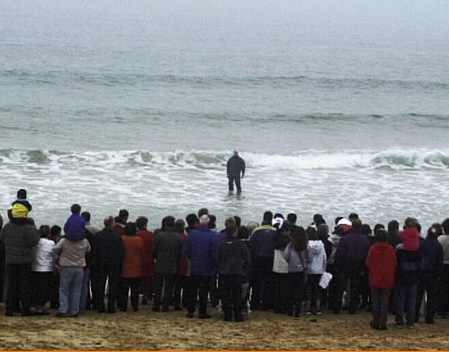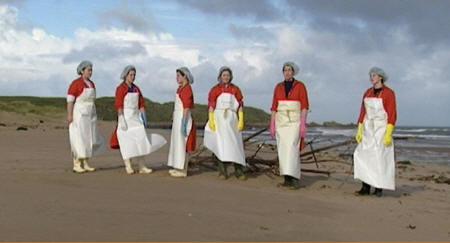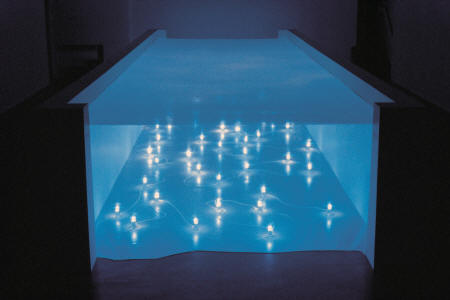|
|
| home | features | exhibitions | interviews | profiles | webprojects | gazetteer | links | archive | forum |
|
Dalziel and Scullion on rurality, remoteness and environmental art Dalziel + Scullion have had solo exhibitions at The Fruitmarket Gallery, Edinburgh, The Arnolfini, Bristol, The Ikon Gallery Birmingham, the Gallery of Modern Art in Glasgow. They were included in the 3rd British Art Show and have shown internationally at the Venice Biennale. They are now based in Dundee where they teach at the University.
You first started working together in 1993.
Were you living in St Combs (on the north-west coast of Scotland) then? What had influenced your decision to
live in this remote fishing village at the time? Matthew and I met when we were both selected for the 1990 British Art Show, when we each worked as individual artists. There were various talks connected with that show, and it was through these that we realised we had shared interests in ideas concerned with what can loosely be described as ‘mankind’s interaction with the ‘natural’ environment’. We got to know each other a bit during that year and in 1991 we made the decision to commence a period of working together, and part of this decision was to relocate to a location that we felt would better support and nurture our interests. After some research we chose a location in Aberdeenshire, on the northeast shoulder of Scotland. Here there seemed to exist a raw expansive wilderness, juxtaposed with a number of hi-tech industries such as oil and gas production - hill top communication installations, together with the more traditional industries of farming and fishing. What interested us was that geography had played a part in why these disparate industries were located there. From an artistic point of view this relocation was a bit of a gamble, as most of our contemporaries were moving to London and America – to be closer to the influence and power of the art world - we were moving north to be surrounded by our subject. We hoped of course that the gamble would pay off, and that we would be able to produce a body of work that could not be made anywhere else and that would have significance within the competitive atmosphere of the art world for that very reason. We spent the next ten years working from the village of St Combs. There we were always considered ‘incomers’ – which isn’t quite as “Wicker Man-ish” as it might sound! But the landscape, the dialect and the people – felt new and different to us, affording an objectivity that fed the work. In tight knit communities, incomers are often permitted to do things that the locals themselves might not, unusual behaviour is excused in a ‘stranger’ that a local person might feel self conscious about.
In 2001 we relocated our practice to a studio
within the University of Dundee where we are currently based.
Three of your films, and probably more than
this, feature St Combs quite prominently. The obvious example is
'Another Place', in which inhabitants of the village are portrayed
standing stationary in the landscape (picture above right). 'Water Falls Down' is a film using
images of water and includes an amazing baptism in the sea (picture
below left), and 'The
Pressure of Spring' features young people growing up in the area and
presumably facing an uncertain future. Have you made other works that
are closely linked to place in this way, and can you describe them
briefly? In 2006 we were commissioned to make a work for the reopening of a large civic gallery in Glasgow (The Kelvingrove) and we made a work called 'The Earth Turned To Bring Us Closer' where we used a telescope motor, converted to combine with a video camera, to film over two hundred portraits of the inhabitants of the city. We had both been students in this city and lived there on and off over the years. The filming was done over a period of six months. We filmed in a large variety of locations throughout Glasgow with the context being as important as the portraits themselves. The work observes the extraordinariness of human life against the often - unimaginable backdrop of the planet spinning in it’s vast orbit. A selection of a species briefly glimpsed in their habitat before they too drift out with our field of vision. In 2005 we made 'Earthdom' where we looked at the landscape of the east Anglian fenlands. Our interest in the interconnectedness of life extends to our own human role within this - of the synthesis between biology and ideas, the tangible links between industrial and social advancements and the inevitable impact of these on local and global environments. For human consciousness to exist at all on earth it must be sustained and nourished by a staggering array and continual flow of substances. Amidst the complex levels of zinc and iron, magnesium and calcium is water - an apparently benign yet crucial substance that finds its way into every minuscule part of us and into every other form of organic life. Our contemporary landscape is now crisscrossed with a network of often invisible conduits of water / energy / communication etc. In this work we explored the notion of the interventions of mankind as being part of rhythms of the landscape - through which water, blood and electricity flow as complex and interconnected systems. In the works that we make we often seek to find new metaphors to interpret the carousel of activity and interdependent relationships that are present in the contemporary landscape.
Its unusual these days to see high-profile
art that is so embedded in a specific place. Many - in the art world
particularly - talk about the fact that we live in a global culture, and
that artists borrow influences from all sorts of unlikely transnational
sources. How do you feel your work - particularly the St Combs work
- relates to a notion of global culture? Is it, for example, purposely
resistive of the seemingly unstoppable and corrosive forces of
globalization?
To be a professional artist means your work is
competing against a lot of other artists for shows in galleries or for
commissions and therefore it is necessary for you to know what is
happening in the art world and be able to make the highest quality of
work you possibly can. This can be difficult from a rural location, as
it is difficult to continually see good work and to develop a network of
colleagues who are making work at a high level. Most art is shown in the
big urban centers and curators are not the best at visiting outside the
big cities - but of course there are some notable exceptions to this.
And their perceptions of work made in a very rural setting will be
different. I mean many still think of landscape-inspired work as being sentimental:
at the
height of the yBa movement hardly anyone in London seemed to be making
this kind of work, for example. But if you’re a Scottish artist
working in the highlands you surely have a different relationship to the
landscape. One that is much more immediate and direct. Is this true?
Were you aware of other Scottish artists that have been inspired by the
landscape in a comparable way in the last 20 years? Perhaps your own
peers?
Sculptures like Sargassum (1995) (above
right) and Voyager (2000) (below left): the former an installation using lights that
creates a sea-like aura in the gallery space, and the latter comprising
tents made out of aluminum, seem different from the St Combs
work. Rather than being a response to a specific place, these seem to be
more about our relationship with the natural world in a more general
sense. These pieces often refer, ironically perhaps, to our need for
oneness with nature. Would you like to comment on this?
|
|
|


 Most of our works respond to a sense of dwelling in a place, but three
that spring to mind are, 'Source' (picture below right) a film we made in 2007, about a
young boys journey through a landscape, it was filmed in the Island of
Mull. The film examined this location through the senses of the boy, his
eyes and ears became portals that sights and sound flow through as he
travelled across the landscape encountering different aspects of its
ecology.
Most of our works respond to a sense of dwelling in a place, but three
that spring to mind are, 'Source' (picture below right) a film we made in 2007, about a
young boys journey through a landscape, it was filmed in the Island of
Mull. The film examined this location through the senses of the boy, his
eyes and ears became portals that sights and sound flow through as he
travelled across the landscape encountering different aspects of its
ecology. 


